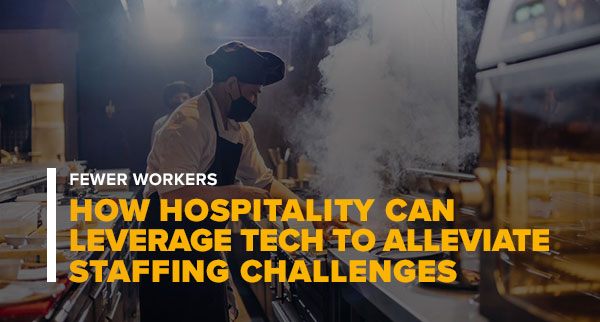June 1, 2021 - By Mark Heymann, CEO, UniFocus - Published in Forbes - The hospitality sector’s record-low revenue per available room (RevPAR) rates and guest volumes as a result of Covid-19 are finally in the rearview mirror, but hotels and restaurants have another crisis on their hands. While demand is returning, their employees are not — and an industry that once accounted for 1 in 25 U.S. jobs now faces a serious staffing shortage problem. Talent acquisition experts labeled 2021 as the beginning of “the great rehire” era for the U.S. economy. For hotels and restaurants, however, the past five months have resembled a far different outlook.
The acceleration of the Covid-19 vaccine rollout, coupled with eased occupancy restrictions and favorable spring weather, has encouraged people to resume traveling and dining in public again, leading to widespread upswings in hospitality labor needs. But hiring hasn’t followed suit, with many businesses struggling to attract interest in their ample job openings. Although restaurant employment rose in March for the third consecutive month, full-service restaurant staffing remained 20% lower than pre-pandemic levels (equating to 1.1 million jobs). And according to U.S. Census survey data from early April, reported on by Axios, 37% of small businesses in hospitality have had their operating ability restricted by staffing shortages.
The industry’s inability to rehire can be attributed to a slim candidate pool stemming from many factors. The pandemic’s increased unemployment benefits may have led some employees on the lower end of the pay scale, such as line cooks and other back-of-the-house positions, to be less inclined to return to the workforce. Another component is that some furloughed hospitality workers switched career paths during the pandemic in search of more stable industries and educational opportunities. Other reasons include hesitancy to return to work and a continued lack of childcare. With millions of hotels and restaurants all reopening (and rehiring) at the same time, competition for the remaining available workers is extremely high.
Labor needs are likely to continue to rise as the pandemic nears its end and the oncoming “tidal wave” of post-pandemic demand moves closer to shore. At UniFocus, we offer labor management technology solutions and have been helping our clients navigate their recent labor shortages and increased demand. I believe it’s imperative for hotels and restaurants to learn how advanced technology can help with this staffing dilemma now before they hinder post-pandemic financial recovery.
Flexible Automated Scheduling
By leveraging artificial intelligence (AI) and advanced forecasting algorithms, labor management technology can flex shift variables in real time to create a flexible workforce that ensures employees maximize the return on their availability. For example, for enterprises forced to weather low staff volumes, technology can be used to forecast small increments of demand and then automate staffing to those increments to ensure operational efficiency. If a restaurant’s forecast projects 200 covers for a Thursday lunch shift, the technology will indicate that 22% of those covers will occur between 11:30 and 11:45 a.m. and make automated scheduling adjustments to meet labor demands. These actionable insights enable enterprises to make effective resource allocations and least-cost decisions while ensuring customer needs are met.
"Traditional models that rely on manual scheduling or single predefined shift times, durations and positions put employees at a disadvantage by reducing their ability to maximize hours and income."
The way I see it, in order to draw former hospitality employees back to the industry, hotels and restaurants should be integrating automation into scheduling processes as much as possible. Traditional models that rely on manual scheduling or single predefined shift times, durations and positions put employees at a disadvantage by reducing their ability to maximize hours and income. Integrating forecasting insights can help to ensure that servers who rely on tips to offset the $2.13 federal minimum wage aren’t stuck working during periods of low demand, especially when some of those hours could be better spent in a non-tipped role.
Access To Alternative Labor Resources
Advanced technology can also enable hotels and restaurants to leverage alternative sources of labor for combating staffing shortages. For instance, enterprises can incorporate nontraditional labor structures that provide a wider array of resources by cross-utilizing employees across multiple franchise locations or enlisting ready-to-work independent contractors to support full-time staff. By using the technology to clarify labor needs and hours available periodically throughout the day, managers can make proactive scheduling decisions and then react in real time when staffing needs to be adjusted.
Then, there’s the concept of hybrid shift durations. Instead of the traditional eight-hour-per-day, five-days-per-week schedule, there are individuals who may prefer four 10-hour shifts or three 12-hour shifts and one four-hour shift to reach their 40 hours. Enterprises can use labor management technology to develop a cross-utilization staffing approach that leverages flexible shift times and durations, offering employees their desired flexibility while still maintaining operational efficiency.
Proactive Employment Partnerships
By leveraging technology, enterprises can also work to facilitate partnerships to weather staffing shortages while simultaneously providing employment for underrepresented working classes. For example:
- Local Colleges: A restaurant franchise could utilize an AI solution to build a digital pool of college students who aren’t considered full-time employees but work various roles at multiple locations when their availability permits. The system’s automated scheduling algorithms can handle the heavy lifting of assigning roles, locations and shift duration/wage adjustments based on demand and labor needs.
- Prisons: A full-service restaurant could utilize an AI solution with automated scheduling to create societal reentry programs, where people recently released from prison can work based on available hours. The restaurant receives staffing support while workers gain employment and learn skills that can help them reacclimate to life outside of prison.
- Disability Centers: A hotel could utilize labor management technology to provide specialized training for individuals with Down syndrome who assist housekeepers with room cleanings and other predefined tasks.
A dynamic, nontraditional approach to labor will be essential for hospitality to overcome the staffing challenges of our new industry environment. In reality, post-pandemic recovery cannot be accomplished amid a staffing shortage crisis. There’s never been a greater need for hotels and restaurants to be innovative and embrace digital adoption as the means to create a flexible workforce that fosters sustained success.






